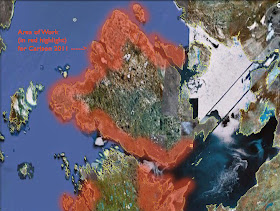Well, the snow keeps coming down here in the Chicago area. Had to delay the crane for hoisting the Beaver again so the main tundra tires can be installed. Looks like the next best bet is scheduling for next weekend, February 12th.
This picture was taken after the new snow today. It is an in progress of construction simulation of what Franklin's tomb probably would be like, if it exists. The rectangular hole in the ground is 2.5' wide x 7' long x 4' plus deep. The cavity is surrounded with a waterproof tarp, which was filled with water last fall up to 6" below grade. Also within the cavity is a wood box, nailed top, brass buttons and other small pieces of metal that might also be found on a captain's uniform. These are the type of targets that can be detected by airborne and ground penetrating radar and magnetometer. The complete section of ice has been completely frozen for 2 months now; a solid underground ice block. Soon stones and gravel fill will be poured in the last 6", then those remaining cavities will be filled with more water, so that the entire area is solid stone and ice.

If
Sir John Franklin's grave does indeed exist up there, it most likely would have been very caringly prepared by his men after his death. They loved their leader. It stands to reason that his grave must have been at least as well prepared (if not better than) as the famous tombs that were found and
exhumed from the first three men that died at the expedition's initial wintering grounds -
Beechey Island. Those men:
Torrington, Hartnell and
Braine, each were frozen in solid ice, even solid ice within their coffins, from water infiltration.
Within the notations of the only note found, that
famous last note from the expedition's officers, Sir John was logged to have died 17 months after these three men. His death was prior to the deaths of most of the men on this expedition. 134 men had set sail on two ships from England (see
entire expedition's muster), 5 were sent home on their last supply pick up, leaving 129 to sail off - never to be heard from again. After Franklin died, most of the men continued on to later find their own slow doom from starvation, over the following 2 or 3 years. Therefor, if Sir John were to have been buried in that traditional manner, he should be to this day very well preserved.
And with him would there be a copy of the ship's papers? The logs of what happened? Maybe. The
Admiralty's orders had set forth that 2 sets of records be kept (Section 22). Finding these invaluable papers would indeed be the holy grail of any search.
This spring, immediately after the snow melt off here, airborne scanning equipment will be tested over this simulated tomb from 2,000 feet AGL and up. These trials will be executed in order to confirm the sensitivity spectrum required, and then enabling correct settings for the final tuning refinement and programming for this summer's 2011 expedition.





